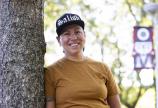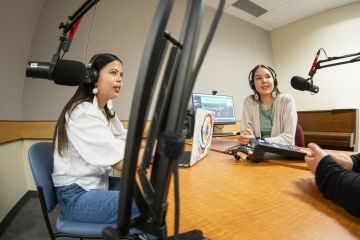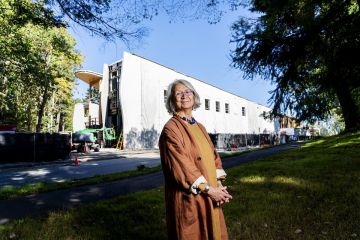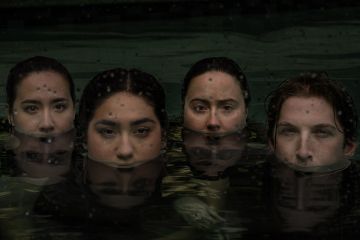New banners carry messages of welcome
- Tara Sharpe
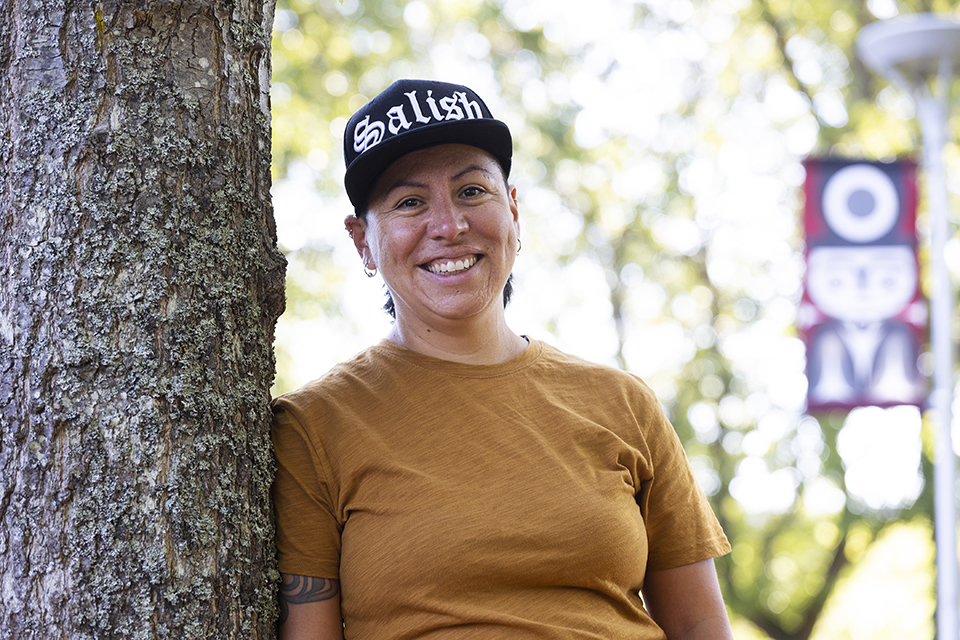
Two banner designs featuring new Indigenous art now float overhead on light posts in the heart of campus as a visual sign of greeting to this place. One features a figure with arms down, designed by the artist as a marker for welcoming visitors and guests to this land of the lək̓ʷəŋən peoples upon whose traditional territory the university stands, with splashes of grey blue evoking the sky and waves of the coast. The other is filled with earth tones of cedar and sand inviting reflections of land and connection, with the second figure’s arms up as a gratitude welcome gesture after feasting.
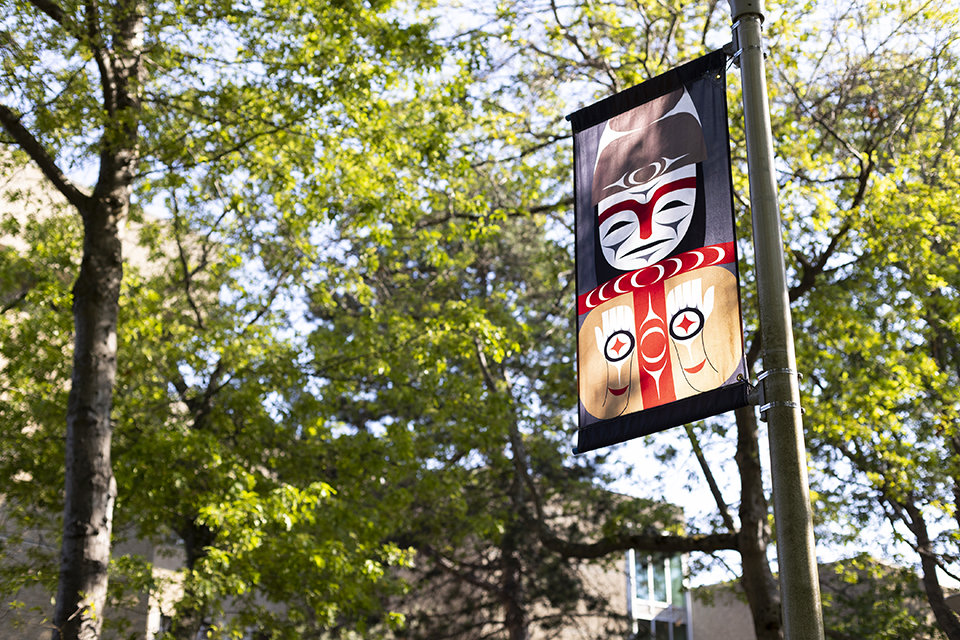
The banners are the artistic creations of Margaret August, a Two-Spirited, Coast Salish, multi-media artist from shíshálh Nation whose work is inspired by traditional teachings and encounters with nature.
UVic-produced video about August and the banners
Welcoming gestures of art
The banners, installed along the 1.2-kilometre campus greenway—including the main pathway near First Peoples House—will be accompanied at night by designs from two spindle whorls, also created by August.
I really wanted a gesture of welcoming, of coming in—for anyone new to campus, Victoria or Canada, and for those who are visitors and guests here, to feel a welcoming that’s compassion for learning about the culture and to get to know the lands that you are on. And for Indigenous students, faculty and staff at UVic, it’s about seeing this art in the centre of the campus.
—Two-Spirit Coast Salish artist Margaret August (shíshálh Nation) born in the lək̓ʷəŋən and WSÁNEĆ territories, who began developing their artistic talents at an early age
On Sept. 7, in gratitude for their contributions to the campus greenway project, August is invited to the second annual Indigenous Welcome to Campus from 12 to 1:30 p.m. in the UVic quad. The event is an important opportunity for the UVic community to come together to acknowledge the traditional territory of the lək̓ʷəŋən peoples, and to experience and learn from the knowledge, teachings and practices of local Indigenous communities. All students, staff and faculty—both Indigenous and non-Indigenous—are welcome to attend.
Artist’s designs light up a path of encouragement
Spindle whorls are typically used by Coast Salish female and Two-Spirit weavers to spin animal hair into wool for textiles. August’s two whorls will be projected by light as stencils on the ground and will be operational very soon. The artist’s work will be lit up all along the greenway from Gordon Head Road to Ring Road, including main entry areas, crosswalks and in all five of the spaces around UVic’s new student housing and dining buildings.
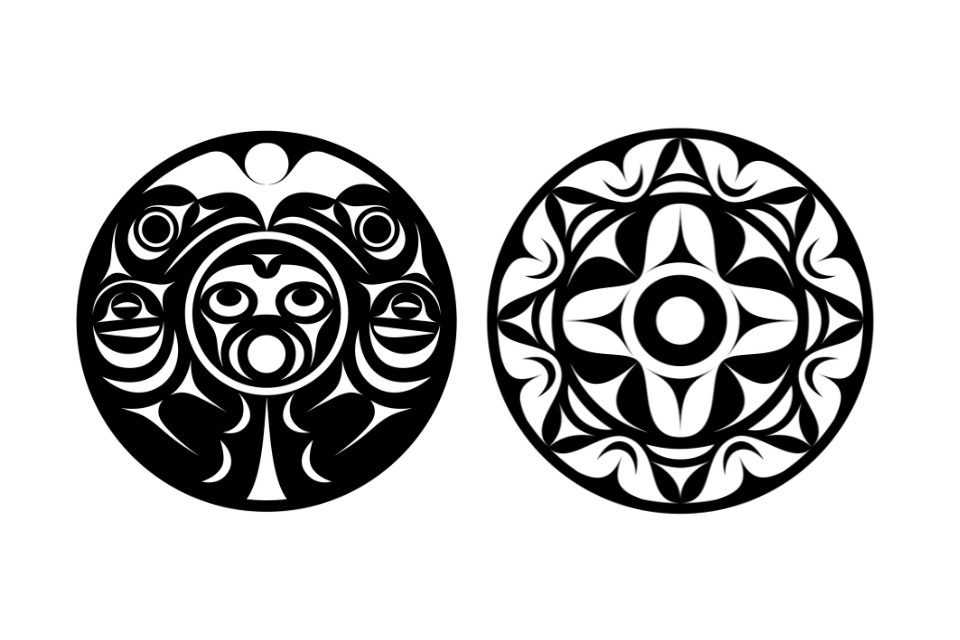
Whirling with the power of flight in a symmetrical eagle design, one of the spindle whorl designs symbolizes a message of encouragement for people to emerge from their comfort zones and rise above challenges, explains August, who has named it “Reaching Greater Heights.”
The other design, called “Salish Medicine,” is also contemporary but August hopes it additionally captures a sense of the “trance-like” experience that is part of the traditional use of these sacred heirlooms when the weaver is spinning the wool.
“I knew this was my life purpose”
In Coast Salish tradition, intricately carved house posts stand at the entrance to traditional longhouses to welcome people into the surroundings. A year before they began work on the UVic project, August was mentoring with a Coast Salish artist “who’s inclined to fall into the history and reviving of Coast Salish house posts. Being his student guided me into that practice of looking back into the history, such as of the works of Master Carver and Tsartlip First Nation artist Charles Elliott in the 1980s. Moving forward from there to now, I want to continue that revival in practice.”
August was born “in the traditional unceded lək̓ʷəŋən and WSÁNEĆ territories now referred to as Victoria,” and recalls their first art supplies being their uncle’s old paintbrushes: “I can picture myself painting at two years old.
“I knew this was my life purpose, to do art. I can’t see myself doing anything different.”
August carried on with their visual art practice into adulthood, with influences also including renowned Musqueam Coast Salish artist Susan Point, Mark Preston (Tlingit) and LessLIE (Coast Salish).
In 2017, August began working under the guidance and mentorship of Qwul'thilum (Dylan Thomas), the well-known Coast Salish artist from Lyackson First Nation of Valdes Island, to sharpen their skillset towards advancements in Salish art and design. The mentorship led to creating art in multiple mediums such as serigraph/giclee prints, glass and cedar sandblasted pieces; they are currently further mentoring with Qwul'thilum in wood carving.
“My interpretation is very contemporary, looking at artifacts,” August says, “with traditional knowledge in mind.
“The people who’ve come along on my path included a person I know in the arts community who asked me, what makes you different? That really made me think. And I realized I use my spiritual encounters with animals and nature to illustrate what I want to convey through art. This medicine comes to me. And I want to share it with people.”
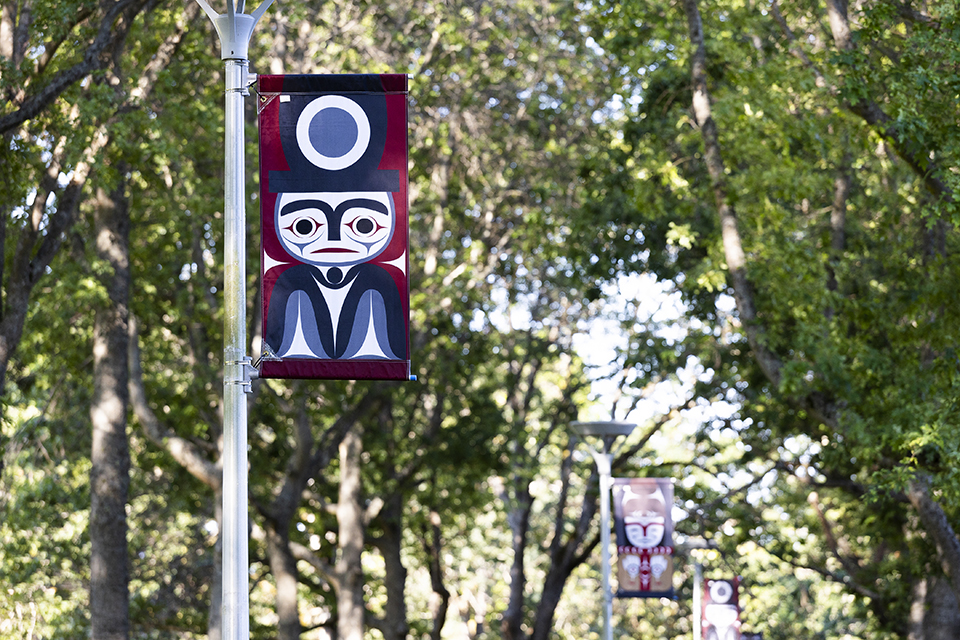
Campus greenway project
The entire greenway runs through the centre of the UVic campus and, when complete, will be a busy and beautiful route for pedestrians and cyclists. It will include ecological features, communal tables, tree canopies, benches and other viewing platforms, as well as interpretive art and signage to highlight Indigenous history, languages and connections to the land.
And paving stones will also be arranged in cedar-weaving design patterns.
A guiding principle of the greenway project is to reflect Indigenous ways of knowing and being within the landscape. I know I speak for others involved in coordinating the project in saying how delighted I am to see Margaret’s artwork now being raised across campus and their contributions toward creating a welcoming and inclusive campus environment.
—Mike Wilson, UVic’s director of campus planning and sustainability
Art on campus and beyond
Putting art at the heart of the UVic experience is nothing new here. Our university has more art on view in public spaces than any other Canadian university.
At any one time, approximately 2,000 pieces of art are in place from more than 19,000 in the university’s overall art collection, all overseen by UVic’s Legacy Art Galleries.
Legacy staff continue to partner every season in artistic and community collaborations that reflect diversity and explore important ideas and today’s most pressing issues, as well as enhancing engagement with communities through programming and a perpetual array of compelling and educational exhibitions.
Legacy Galleries is delighted to forge connections between campus and Indigenous artists with this project. This is an opportunity to move artwork outside the gallery walls to the land, to celebrate and foreground Coast Salish artists and communicate our commitment to reconciliation.
—Caroline Riedel, acting director of UVic’s Legacy Art Galleries
Legacy has three main spaces for rotating exhibitions: Legacy Downtown, which is UVic’s free public art gallery in the downtown core, Legacy Maltwood and in First Peoples House.
Find out more
Photos
In this story
Keywords: Indigenous, art, student life, reconciliation, administative
People: Margaret August, Mike Wilson, Caroline Riedel
Publication: The Ring

